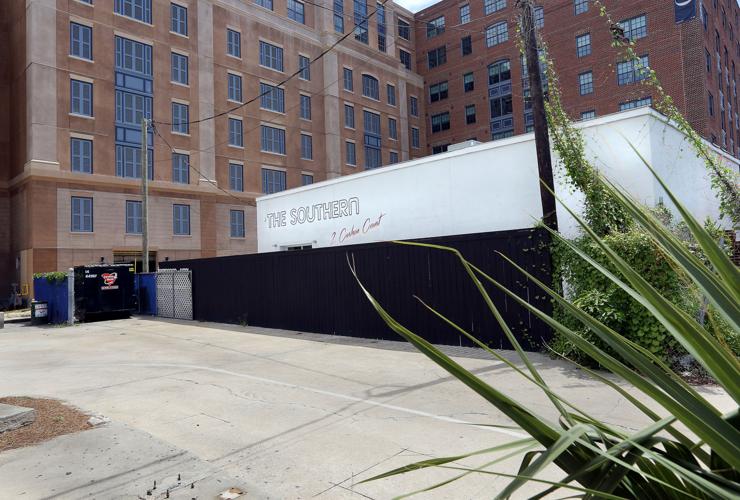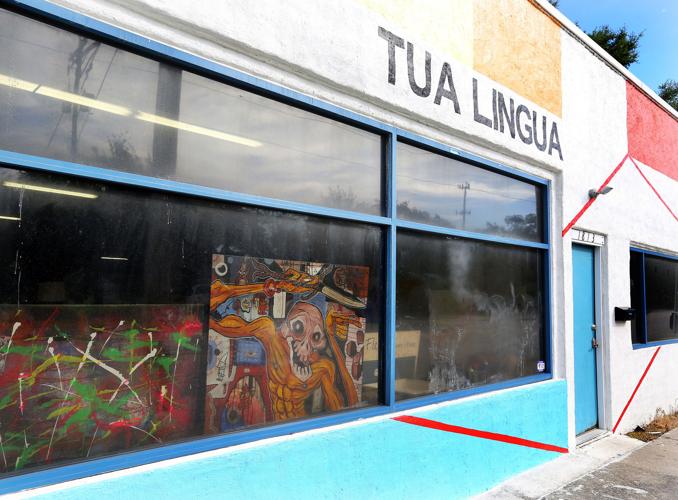A pattern has emerged. Well-intentioned artists and entrepreneurs secure a scrappy space, convert it into a cool venue and gathering place, then lose it because of rent increases and other economic pressures.
It happened to Fabulon in West Ashley.
It happened to The Southern gallery on the peninsula.
It’s happening to Tua Lingua Art Studio in North Charleston.
It’s happening to Cone 10 Studios on the Neck.
Some arts venues are luckier than others; they find a new space when pushed out of the old one, or simply chose to move. Redux was forced out of its quirky building wedged between King and St. Philip streets more than a year ago but managed to settle into a bigger, better, brighter building on Upper King Street.
Pure Theatre has abandoned its imperfect storefront space on King Street and taken up residency in the old Zion-Olivet Presbyterian Church at 134 Cannon St., now called the Cannon Street Art Center.
Anne Siegfried of The George Gallery, located on Bogard Street for several years, jumped at the chance to occupy a gallery at 54 Broad St. where Ann Long and John Doyle once held forth.
But for most, it’s a struggle to find long-term space at an affordable price, especially in a city where revenues and income cannot possibly keep up with skyrocketing rents.
Fiorenzo Berardozzi, one of three owners of Cone 10 Studios, said about 20 clay artists use the 3,000-square-foot facility, which has been operating as an gathering place for potters for nearly 20 years, thanks to the generosity of the owner of the building and approximately two acres of land surrounding it.
But now the property is for sale, and far too expensive for the group of artists to purchase, Berardozzi said.
“So we are sort of in a holding pattern, in the sense that we are planning on staying there until the last possible moment,” he said. “It’s very difficult to continue with the business when there are a lot of question marks. We have been looking around, but that also creates another barrier.”
How can Cone 10 Studios operate at a low cost and afford to pay today’s rent?
So Berardozzi, who makes dishes for The Daily, Butcher & Bee, Husk and others, has set up a workspace in his home. Co-owner Ann John has a studio in her backyard, and co-owner Susan Gregory is looking around, Berardozzi said.
“Cone 10 will try to survive,” he said. “Someone might take it over and try to keep things afloat.”
Costco and car lots
Since leaving the building occupied by Fabulon on Wappoo Road in West Ashley, Susan Irish has been making art and teaching students at her home, and curating small exhibits for Elise Richard at Avondale Therapy.
She would love to find a new venue for Fabulon, create a flexible space, host an open mic night, teach classes and mount shows. Maybe forming a collective of artists who can pool resources is the way to go. It’s no easy task, especially in sprawling West Ashley, she said.
“I love the idea of like-minded people getting together to have a place where it could be flexible,” Irish said. “People need spaces to gather.”
On the other hand, suburban Charleston is not exactly known as a cultural center.
“People don’t think about West Ashley except for Costco or car lots,” she said. They don’t tend to seek out art studios and galleries in that part of town.
But perhaps that’s precisely why the area could benefit from a vibrant, community-oriented art venue.
“Ideally, I would like to buy a building as opposed to being at the mercy of another landlord again,” Irish said. “But to start on a long-term mortgage at midlife, I would need someone else to work with me, and artists to sign on to the concept.”
Does the right building even exist? Probably not, she said.
“And if it did, would someone else snatch it up first?”
Probably. It’s a Catch-22: Young artists can’t afford high rents, and established artists generally don’t need cheap, shared studio space.
The thing that matters
In North Charleston, the fate of Tua Lingua Arts Studio on Reynolds Avenue is in doubt. Proprietor Nathan Petro is done, unable to meet the financial demands of his landlord, even if the space is well used by a group of visual artists and musicians.
Possibly a new arrangement will be made with resident artists, but nothing is sure. Meanwhile, Petro is organizing a final hurrah, an art show 7-11 p.m. Sunday, July 15, followed by a one-man play by Rush Hicks called “Welcome to Coney,” which runs at 8:30 p.m. June 17, 19, 20 and 21.
For Petro, a musician who does swimming pool maintenance by day, Tua Lingua has been a labor of love, and walking away is difficult, he said.
“It’s a loss of identity,” Petro said. “This is the thing that I do that matters.”
About 10 artists use the space. They have 24/7 access, pay a modest fee and volunteer four hours each month. It’s very old-school, analog, word-of-mouth: People gather for eclectic performances, put up flyers around town, show art.
“This is wildly unpredictable,” Petro said of the enterprise. “If you don’t love that, don’t do it.”
He’s done it for several years, on Dorchester Road, on Upper King Street and now on Reynolds Avenue, coping with challenges at each location.
"I only started Tua Lingua because of an absence of what I needed and wanted to see in Charleston. And although, yes, the city is getting hit with a lot of sequential loss in the arts and music scene, it’s that very loss and the emptiness it creates that will pull the next person to do something about it, take the initiative, and create something new. It’s inevitable.”
Invest with caution
Justin and Erin Nathanson, who operate The Southern gallery, a virtual enterprise now that they left the little building they rented near the corner of Meeting and Line streets, said they wonder about the fate of contemporary art in town.
Charleston, they said, likes to think of itself as a sophisticated, world-class destination for art and culture, but the number of local residents who invest in the arts is relatively small, public support for arts initiatives is relatively limited and city policies are more aligned with real estate development than with fostering a vibrant contemporary arts scene.
Retail space costs renters an average of about $50 a square foot in downtown Charleston, according to the firm Lee & Associates. That’s more expensive than a lot of property in New York City, Erin Nathanson noted.
And the assistance provided by local municipalities to arts organizations in search of space is limited. No tax breaks, no developer incentives, no art tax, no special fund or impact fees. The cities of Charleston and North Charleston do provide modest grants to arts groups, funded by an accommodations tax, but use of the money is limited to “activities related to tourism.”
Local nonprofits, such as the Coastal Community Foundation and Donnelley Foundation also provide some grant funding to arts organizations, but such funding typically is meant for specific projects, not general operations.
The Nathansons struggled to keep their venue open as Courier Square, located on land owned by The Post and Courier's parent company, was erected behind them, disrupting sewer, power and access to the building. Eventually, they gave up. The experience left a bad taste in their mouths.
“It makes us really hesitant to invest in Charleston right now,” Erin Nathanson said. “I would say anyone should be cautious about opening a business here.”
Now they are rethinking their approach and business model, considering their options here and elsewhere.
Change is afoot
Ann Simmons, deputy director of North Charleston’s Cultural Affairs Department, said venues for arts organizations have been an issue for many years.
“Every time we’ve had a venue we’ve made it work for a limited amount of time, and then it goes away for whatever reason.”
One big reason is the Cultural Affairs budget is too small and too limited to include options to purchase, renovate or develop venues. All Simmons and her team can do is provide modest grants, logistical support and temporary access to spaces controlled by the department.
Currently, North Charleston operates only a handful of venues, she said: the Old Village Community Building (available for rent), Midland Park Art Center (a rehearsal space), City Hall (whose walls are made available for art exhibits) and the old fire station on Reynolds Avenue (used for temporary art shows).
In 2015, the city lost the low-rent auditorium Sterrett Hall and the Rhodes Art Center, located on the old Navy base. That left some community-based performing groups and visual artists high and dry. For a while, the city considered transforming the Garko building, an old mill near Park Circle, into an art space, but remediation and re-development costs were found to be prohibitive, so the city sold the property, Simmons said.
For the last few years, Mary Gould of South of Broadway Theatre Company and others worked to establish a performing arts center on Daniel Island, but plans recently were abandoned because of high anticipated costs.
But change is afoot in North Charleston, especially around Park Circle and near the old Navy base. Dilapidated properties could become new arts venues with the right planning, funding and vision. Already the community development corporation Metanoia is reimagining Chicora Elementary School, which could include arts studios and performance space.
All it takes is money, creative collaboration and collective determination — things that have often proven to be elusive in the Charleston area.
“We’re trying to evaluate how (the North Charleston) community will evolve before committing to anything,” Simmons said.











